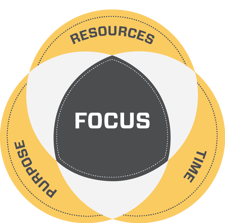Designing a new building is an undertaking that demands time, expertise and vision from all involved. Many on the owner’s team find themselves taking on important new roles and tasks in addition to their normal duties. Members of the design team must learn about critical client needs and begin responses in dozens of design tracks.
While developing an action plan of key tasks, a schedule of milestones and a team communication plan are essential, none of those guarantee that you have secured the most valuable asset: the team’s focus.

Focus is that mental state where people’s attention is directed and sustained. They are in a mode where they can concentrate and peruse different paths of uninterrupted thought. Allowing an individual to reach a place of focus typically involves having a defined task or problem, supporting information and resources at hand, and an appropriate block of uninterrupted time. Put more directly, they have purpose, resources and time. The benefits of these focused periods can be immense – particularly when they occur at the right time in the overall process. People gain new insights, which lead to potential solutions they can carefully study, as well as the ability to make quality decisions more quickly. By looking at a project’s process through the lens of achieving focus, we can begin to leverage its benefits across the entire team for both clients and consultants.
Here are some strategies that encompass the dimensions of purpose, resources and time to increase team focus:
Develop an Action Plan and Share it with all Participants
Work with the team to develop a single, ‘living’ document that illustrates the order of key tasks, meetings, owner sign-offs and milestone deliverables that the whole team can reference. Developing and sharing an action plan with all participants will be invaluable in focusing the team on how to pursue tasks.
Allow Members to ‘Own’ Task Assignments and Set Realistic Goals
Assigning specific tasks or issues to individual team members that they will ‘own’ for the life of the project is easier said than done when balancing project needs against other demands on your team members.
Ideally, during the beginning stages of project planning you should assign tasks with project-driven specifics, such as operating suites or lobby spaces, to team members who can bring dedicated expertise for the project duration. Regardless of task assignment, it is important to understand how much time a task is going to take in order to set realistic goals.
- What are the key steps?
- Who else, internally or externally, should you consult?
- When are they available to talk?
- Who needs to sign off before the next step?
Understand and Plan Around Team Availability
We appreciate our clients’ time constraints and need to be prepared to use their time wisely. Not only is it important to truly understand your own team’s availability—from conference attendance to vacations to other project commitments—and plan accordingly, but also understand the schedules of the Owner and CM firm. This knowledge is especially critical when planning for key meetings or delivering milestones.
Collaborate with Meeting Participants When Setting Up Meetings or Work Sessions
This is not a new idea, rather one worth repeating as project teams still hold meetings that have as many purposes as participants – or worse, no purpose at all. While preparing for a meeting or work session, work with participants to develop an agenda that clearly communicates the purpose and goal of the meeting. Additionally, you should mutually arrive at what participants must bring to help the rest of the team on the objective.

To achieve a meeting’s purpose and goal in a timely manner, consult with team members on how much time they need to present material or coordinate with others. Their answers will sometimes surprise you and you may need to be open to changing the agenda to accommodate.
Implementing ways to increase focus during the project will ultimately provide a better design process experience for all involved, and help achieve the desired results for the owner.


